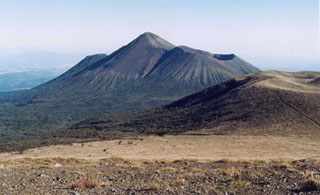Report on Kirishimayama (Japan) — 19 January-25 January 2011
Smithsonian Institution / US Geological Survey
Weekly Volcanic Activity Report, 19 January-25 January 2011
Managing Editor: Sally Sennert.
Please cite this report as:
Global Volcanism Program, 2011. Report on Kirishimayama (Japan) (Sennert, S, ed.). Weekly Volcanic Activity Report, 19 January-25 January 2011. Smithsonian Institution and US Geological Survey.
Kirishimayama
Japan
31.934°N, 130.862°E; summit elev. 1700 m
All times are local (unless otherwise noted)
According to JMA, an eruption from Shinmoe-dake (Shinmoe peak), a stratovolcano of the Kirishima volcano group, on 19 January produced a shock wave that was detected 12 km NE and an ash plume that drifted SE. Ashfall up to 5 mm thick was reported in Miyakonojo (30 km SE); ashfall was also reported as far as Nichinan City (60 km SE). An eruption on 22 January ejected material 200 m above the vent. Based on reports from JMA and pilot observations, the Tokyo VAAC reported that ash plumes rose to altitudes of 1.8-2.1 km (6,000-7,000 ft) a.s.l. and drifted SE.
Geological Summary. Kirishimayama is a large group of more than 20 Quaternary volcanoes located north of Kagoshima Bay. The late-Pleistocene to Holocene dominantly andesitic group consists of stratovolcanoes, pyroclastic cones, maars, and underlying shield volcanoes located over an area of 20 x 30 km. The larger stratovolcanoes are scattered throughout the field, with the centrally located Karakunidake being the highest. Onamiike and Miike, the two largest maars, are located SW of Karakunidake and at its far eastern end, respectively. Holocene eruptions have been concentrated along an E-W line of vents from Miike to Ohachi, and at Shinmoedake to the NE. Frequent small-to-moderate explosive eruptions have been recorded since the 8th century.
Sources: Tokyo Volcanic Ash Advisory Center (VAAC), Japan Meteorological Agency (JMA)

